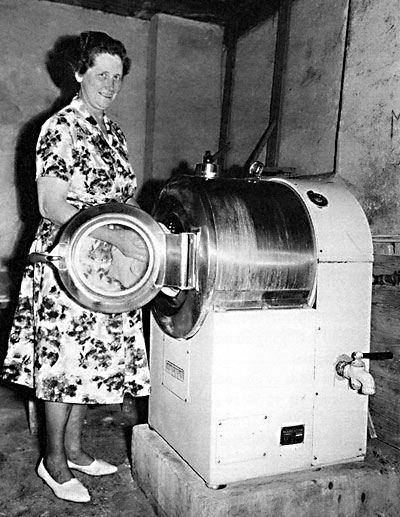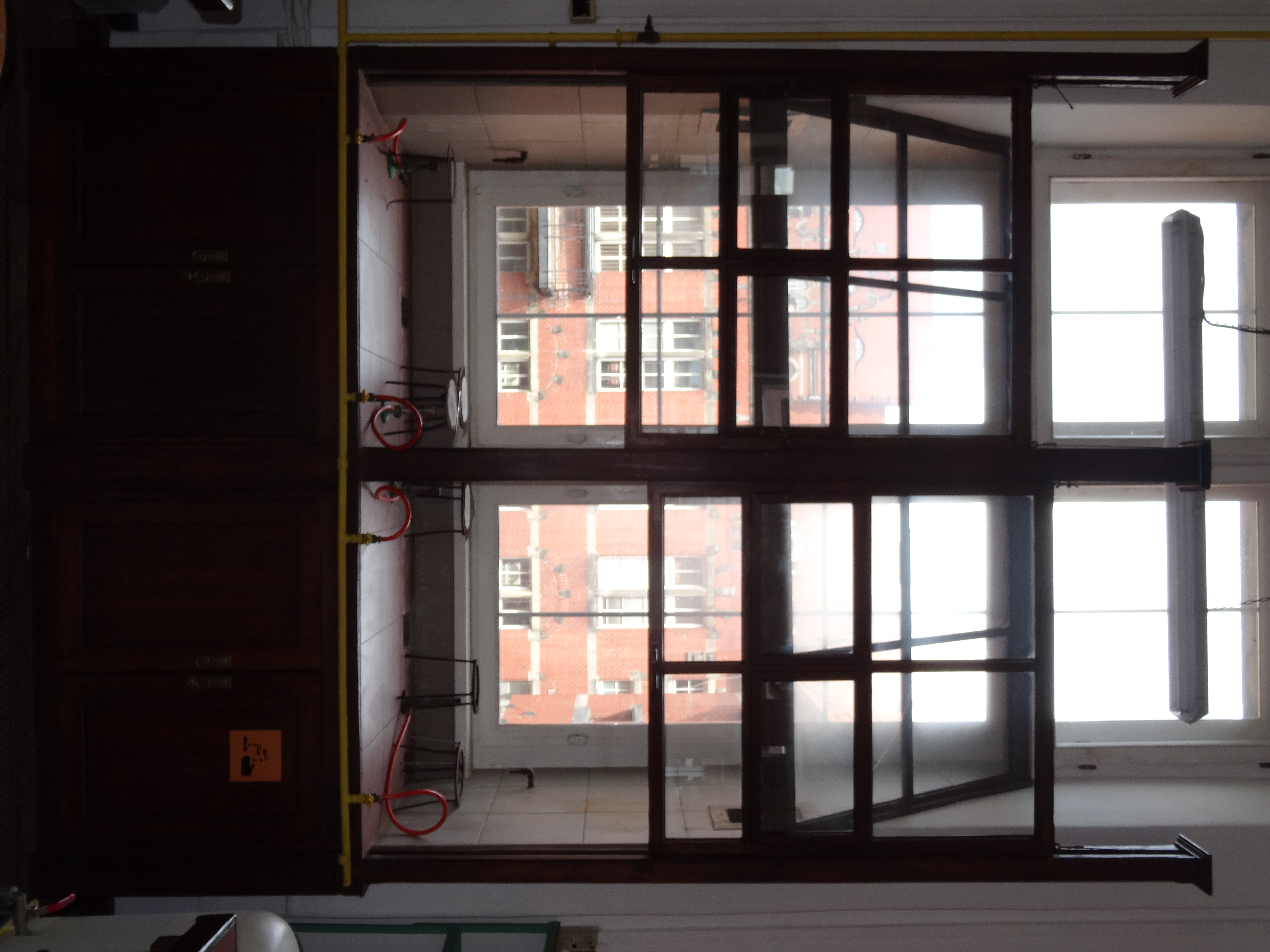|
Range Hood
A kitchen hood, exhaust hood, hood fan, extractor hood, or range hood is a device containing a mechanical fan that hangs above the stove or cooktop in the kitchen. It removes airborne grease, combustion products, fumes, smoke, heat, and steam from the air by evacuation of the air and filtration. In commercial kitchens exhaust hoods are often used in combination with fire suppression devices so that fumes from a grease fire are properly vented and the fire is put out quickly. Commercial vent hoods may also be combined with a fresh air fan that draws in exterior air, circulating it with the cooking fumes, which is then drawn out by the hood. In most exhaust hoods, a filtration system removes grease (the grease trap) and other particles. Although many vent hoods exhaust air to the outside, some recirculate the air to the kitchen. In a recirculating system, filters may be used to remove odors in addition to the grease. The device is known as an extractor hood in the United Kingdom, ... [...More Info...] [...Related Items...] OR: [Wikipedia] [Google] [Baidu] |
Hearing Loss
Hearing loss is a partial or total inability to hear. Hearing loss may be present at birth or acquired at any time afterwards. Hearing loss may occur in one or both ears. In children, hearing problems can affect the ability to acquire spoken language, and in adults it can create difficulties with social interaction and at work. Hearing loss can be temporary or permanent. Hearing loss related to age usually affects both ears and is due to cochlear hair cell loss. In some people, particularly older people, hearing loss can result in loneliness. Hearing loss may be caused by a number of factors, including: genetics, ageing, exposure to noise, some infections, birth complications, trauma to the ear, and certain medications or toxins. A common condition that results in hearing loss is chronic ear infections. Certain infections during pregnancy, such as cytomegalovirus, syphilis and rubella, may also cause hearing loss in the child. Hearing loss is diagnosed when hearing ... [...More Info...] [...Related Items...] OR: [Wikipedia] [Google] [Baidu] |
Air Filters
A particulate air filter is a device composed of fibrous, or porous materials which removes particulates such as smoke, dust, pollen, mold, viruses and bacteria from the air. Filters containing an adsorbent or catalyst such as charcoal (carbon) may also remove odors and gaseous pollutants such as volatile organic compounds or ozone. Air filters are used in applications where air quality is important, notably in building ventilation systems and in engines. Some buildings, as well as aircraft and other human-made environments (e.g., satellites, and Space Shuttles) use foam, pleated paper, or spun fiberglass filter elements. Another method, air ionizers, use fibers or elements with a static electric charge, which attract dust particles. The air intakes of internal combustion engines and air compressors tend to use either paper, foam, or cotton filters. Oil bath filters have fallen out of favour aside from niche uses. The technology of air intake filters of gas turbines has improv ... [...More Info...] [...Related Items...] OR: [Wikipedia] [Google] [Baidu] |
Home Appliances
A home appliance, also referred to as a domestic appliance, an electric appliance or a household appliance, is a machine which assists in household functions such as cooking, cleaning and food preservation. The domestic application attached to home appliance is tied to the definition of appliance as "an instrument or device designed for a particular use or function". ''Collins English Dictionary'' defines "home appliance" as: "devices or machines, usually electrical, that are in your home and which you use to do jobs such as cleaning or cooking". The broad usage allows for nearly any device intended for domestic use to be a home appliance, including consumer electronics as well as stoves, refrigerators, toasters and air conditioners. The development of self-contained electric and gas-powered appliances, an American innovation, emerged in the early 20th century. This evolution is linked to the decline of full-time domestic servants and desire to reduce household chores, allowing ... [...More Info...] [...Related Items...] OR: [Wikipedia] [Google] [Baidu] |
Smoke Canopy
A smoke canopy is a device hung over a fire to gather the smoke and vent it through a wall or roof. Fireplaces were not used during much of the Middle Ages, because there were no chimneys, which were not invented and popularized until the 12th century. Most fires for heating were placed on hearths in the middles of rooms, and the smoke was allowed to rise to vents in the roof or high in walls. Smoke canopies provided an alternative, gathering the smoke above a fire and venting, usually through a wall clearing the living area from harmful chemicals. Most of the pictures we have of medieval smoke canopies show them being used in kitchens. They usually appeared over hearths that were placed against stone walls. Some were over freestanding hearths, but this required special venting of the smoke. Fire canopies are used to this day, especially in summer houses and mountain lodges as an alternative to expensive fireplaces. See also *See Exhaust hood A kitchen hood, exhaust hood, ... [...More Info...] [...Related Items...] OR: [Wikipedia] [Google] [Baidu] |
Kitchen Ventilation
Kitchen ventilation is the branch of ventilation specialising in the treatment of air from kitchens.http://www.hse.gov.uk/pubns/cais10.pdf It addresses the problems of grease, smoke and odours not found in most other ventilation systems. Kitchen ventilation equipment includes an extractor hood or canopy, and a filtering system. The system's fan may be located in the kitchen or in its ducts. Requirements An adequate kitchen ventilation system should: * Remove cooking fumes at the source, i.e. as close as possible to the cooking equipment. * Remove excess hot air and introduce cool clean air, maintaining a comfortable environment. Inadequate ventilation can cause stress, contributing to unsafe working conditions and high staff turnover. * Ensure that air movement in the kitchen does not cause discomfort. * Provide sufficient air for complete combustion at fired appliances, and prevent the risk of carbon monoxide accumulation. * Be easy to clean (intermittent e.g., manually, ... [...More Info...] [...Related Items...] OR: [Wikipedia] [Google] [Baidu] |
Fume Hood
A fume hood (sometimes called a fume cupboard or fume closet, not to be confused with Extractor hood) is a type of local exhaust ventilation (architecture), ventilation device that is designed to prevent users from being exposed to hazardous fumes, vapors, and dusts. The device is an enclosure with a movable sash window on one side that traps and exhausts gases and particulates either out of the area (through a duct (industrial exhaust), duct) or back into the room (through air filter, air filtration), and is most frequently used in laboratory settings. The first fume hoods, constructed from wood and glass, were developed in the early 1900s as a measure to protect individuals from harmful gaseous reaction by-products. Later developments in the 1970s and 80s allowed for the construction of more efficient devices out of Powder coating, epoxy powder-coated steel and flame-retardant plastic laminates. Contemporary fume hoods are built to various standards to meet the needs of diff ... [...More Info...] [...Related Items...] OR: [Wikipedia] [Google] [Baidu] |
Cubic Foot
The cubic foot (symbol ft3 or cu ft) , . is an Imperial unit, imperial and US customary (non-metric) unit of volume, used in the United States and the United Kingdom. It is defined as the volume of a with sides of one () in |
Cubic Meters Per Second
Cubic metre per second or cubic meter per second in American English (symbol m3s−1 or m3/s) is the unit of volumetric flow rate in the International System of Units (SI). It corresponds to the exchange or movement of the volume of a cube with sides of in length (a cubic meter, originally a ''stere'') each second. It is popularly used for water flow, especially in rivers and streams, and fractions for HVAC values measuring air flow. The term ''cumec'' is sometimes used as an acronym for full unit name, with the plural form ''cumecs'' also common in speech. It is commonly used between workers in the measurement of water flow through natural streams and civil works, but rarely used in writing. Data in units of m3s−1 are used along the y-axis or vertical axis of a flow hydrograph, which describes the time variation of discharge of a river (the mean velocity multiplied by cross-sectional area). A moderately sized river discharges in the order of 100 m3s−1. Conversions ... [...More Info...] [...Related Items...] OR: [Wikipedia] [Google] [Baidu] |
Liter
The litre ( Commonwealth spelling) or liter ( American spelling) (SI symbols L and l, other symbol used: ℓ) is a metric unit of volume. It is equal to 1 cubic decimetre (dm3), 1000 cubic centimetres (cm3) or 0.001 cubic metres (m3). A cubic decimetre (or litre) occupies a volume of (see figure) and is thus equal to one-thousandth of a cubic metre. The original French metric system used the litre as a base unit. The word ''litre'' is derived from an older French unit, the '' litron'', whose name came from Byzantine Greek—where it was a unit of weight, not volume—via Late Medieval Latin, and which equalled approximately 0.831 litres. The litre was also used in several subsequent versions of the metric system and is accepted for use with the SI, despite it not being an SI unit. The SI unit of volume is the cubic metre (m3). The spelling used by the International Bureau of Weights and Measures is "litre", [...More Info...] [...Related Items...] OR: [Wikipedia] [Google] [Baidu] |
Sone
The sone () is a unit of loudness, the subjective perception of sound pressure. The study of perceived loudness is included in the topic of psychoacoustics and employs methods of psychophysics. Doubling the perceived loudness doubles the sone value. Proposed by Stanley Smith Stevens in 1936, it is not an SI unit. Definition and conversions According to Stevens' definition, a loudness of 1 sone is equivalent to 40 phons (a 1 kHz tone at 40 dB SPL). The phons scale aligns with dB, not with loudness, so the sone and phon scales are not proportional. Rather, the loudness in sones is, at least very nearly, a power law function of the signal intensity, with an exponent of 0.3. With this exponent, each 10 phon increase (or 10 dB at 1 kHz) produces almost exactly a doubling of the loudness in sones. : At frequencies other than 1 kHz, the loudness level in phons is calibrated according to the frequency response of human hearing, via a set of e ... [...More Info...] [...Related Items...] OR: [Wikipedia] [Google] [Baidu] |
A-weighting
A-weighting is a form of frequency weighting and the most commonly used of a family of curves defined in the International standard IEC 61672:2003 and various national standards relating to the measurement of sound pressure level. A-weighting is applied to instrument-measured sound levels in an effort to account for the relative loudness perceived by the human ear, as the ear is less sensitive to low audio frequencies. It is employed by arithmetically adding a table of values, listed by octave or third-octave bands, to the measured sound pressure levels in dB. The resulting octave band measurements are usually added (logarithmic method) to provide a single A-weighted value describing the sound; the units are written as dB(A). Other weighting sets of values – B, C, D and now Z – are discussed below. The curves were originally defined for use at different average sound levels, but A-weighting, though originally intended only for the measurement of low-level sounds (aro ... [...More Info...] [...Related Items...] OR: [Wikipedia] [Google] [Baidu] |






